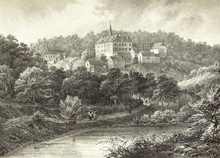- Fischbach Castle
-
 Drawing by Nicolas Liez (1834)
Drawing by Nicolas Liez (1834)
Fischbach Castle (Luxembourgish: Schlass Fëschbech, French: Château de Fischbach, German: Schloss Fischbach) is a castle in Luxembourg. It is situated near the town of Fischbach, in central Luxembourg.[1]
History
Fischbach has the longest history of any of Luxembourg's castles. The estate of Fischbach was originally owned by Abbey of Echternach, which was the wealthiest institution in Luxembourg for centuries. The first liege independent of the Church is recorded as having taken possession of the castle in 1050. The castle underwent several renovations and alterations, including being completely destroyed in 1635, during the Thirty Years' War.[1]
During the second quarter of the 19th Century, the castle was owned by Auguste Garnier, an industrialist and metallurgist, who had turned the estate into an industrial centre by building blast furnaces there. The castle was first acquired by a head of state in 1850, when Grand Duke William II bought the estate to consolidate his political control of Luxembourg and to placate the local populace after the Belgian Revolution. He immediately ordered the demolition of Garnier's blast furnaces.[2]
In 1884, Fischbach Castle was bought from Grand Duke William III by Duke Adolphe of Nassau, who would become Grand Duke of Luxembourg when the personal union of the Netherlands and Luxembourg ended in 1890.[1]
During the Nazi occupation of the Second World War, Fischbach was converted into a rest home for German artists, calling it Künstlerheim Fischbach. Despite this designation, Fischbach did not avoid the looting of art and historic artefacts that befell other palaces in Luxembourg. However, unlike the other palaces, it was not renovated or partly demolished to suit the Nazis' intentions, leaving it habitable by Grand Duchess Charlotte when she returned from exile.[2]
Due to the unsuitability of the other royal palaces, Charlotte continued to live at Fischbach after the war, and took a liking to the place. Even after the full restoration of Berg Castle and the Grand Ducal Palace, Grand Duchess Charlotte remained at Fischbach for the rest of her reign. Indeed, even after she abdicated, in 1964, she decided to live at Fischbach until she died in 1985. Two years after Charlotte's death, Prince Henri and Princess Maria Teresa moved into the castle, where they lived until Henri succeeded his father, Jean, as Grand Duke, in 2000.[2]
See also
References
- ^ a b c "Château de Fischbach", Cour grand-ducale de Luxembourg. (French) Retrieved 9 March 2011.
- ^ a b c "Les résidences de la Famille grand-ducale", Gouvernement luxembourgeois. (French) Retrieved 9 March 2011.
Luxembourg City
and surroundingsAnsembourg · New Castle of Ansembourg · Beggen · Berg · Colpach · Dommeldange · Fischbach · Grand Ducal Palace, Luxembourg · Heisdorf · Hesperange · Hollenfels · Koerich · La Fontaine, Luxembourg · Mamer · Mersch · Meysembourg · Munsbach · Pettingen · Schauwenburg, Bertrange · Schoenfels · Senningen · Septfontaines · Château de Septfontaines, Luxembourg · Useldange · WalferdangeArdennes
and the NorthBourscheid · Brandenbourg · Clervaux · Erpeldange · Esch-sur-Sûre · Schuttbourg · Stolzembourg · Urspelt · Vianden · WiltzEchternach
and surroundingsMoselle
and south-westAspelt · Bettange-sur-Mess · Bettembourg · Clemency · Differdange · Dudelange · Sanem · Schengen · Stadtbredimus · WintrangeCategories:- Castles in Luxembourg
- Fischbach
Wikimedia Foundation. 2010.
